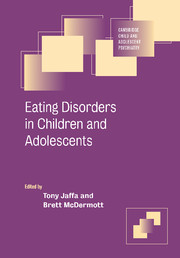Book contents
- Frontmatter
- Contents
- List of Contributors
- Part I Introduction
- Part II Scientific underpinnings
- 2 Regulation of food intake and body weight
- 3 The development of children's shape and weight concerns
- 4 Relation of dieting to eating pathology
- 5 Physical and cognitive changes associated with puberty
- 6 Genetic influences in the development of eating disorders
- 7 Epidemiology of eating disorders
- 8 Neuroimaging
- Part III Abnormal states
- Part IV Evidence-based care
- Part V Public health perspectives
- Index
- References
3 - The development of children's shape and weight concerns
from Part II - Scientific underpinnings
Published online by Cambridge University Press: 02 December 2009
- Frontmatter
- Contents
- List of Contributors
- Part I Introduction
- Part II Scientific underpinnings
- 2 Regulation of food intake and body weight
- 3 The development of children's shape and weight concerns
- 4 Relation of dieting to eating pathology
- 5 Physical and cognitive changes associated with puberty
- 6 Genetic influences in the development of eating disorders
- 7 Epidemiology of eating disorders
- 8 Neuroimaging
- Part III Abnormal states
- Part IV Evidence-based care
- Part V Public health perspectives
- Index
- References
Summary
Introduction
Body shape, weight and eating concerns are at the heart of the psychopathology of eating disorders. Journal and magazine surveys report these concerns as commonplace but at their threatening peak during girls' adolescence. The convergence of pubertal growth with social and identity demands underpins body dissatisfaction and fuels behaviours intended to achieve physical change or gain control. Concepts such as thin-ideal internalization help make sense of this process, describing the way an individual cognitively buys into socially defined ideals of attractiveness (Thompson & Stice, 2001). For many, the result is body dissatisfaction since the ideal is some distance from self-appraised reality. And the culprits are easy to identify – fashion models and celebrities, given saturating media coverage and respect by peers and family. However, often overlooked is the way that obesity's negative representation serves to further idealize a thin body.
It is more difficult to say when this process starts, whether these concerns arrive in a rush or have a long gestation. But it seems likely, given the importance of appearance in adult society, that children both ingest and enact these tensions. The purpose of this chapter is to consider what we currently know about the development of children's shape and weight concerns and associated body dissatisfaction. When do they develop and what are their drivers?
- Type
- Chapter
- Information
- Eating Disorders in Children and Adolescents , pp. 32 - 44Publisher: Cambridge University PressPrint publication year: 2006

